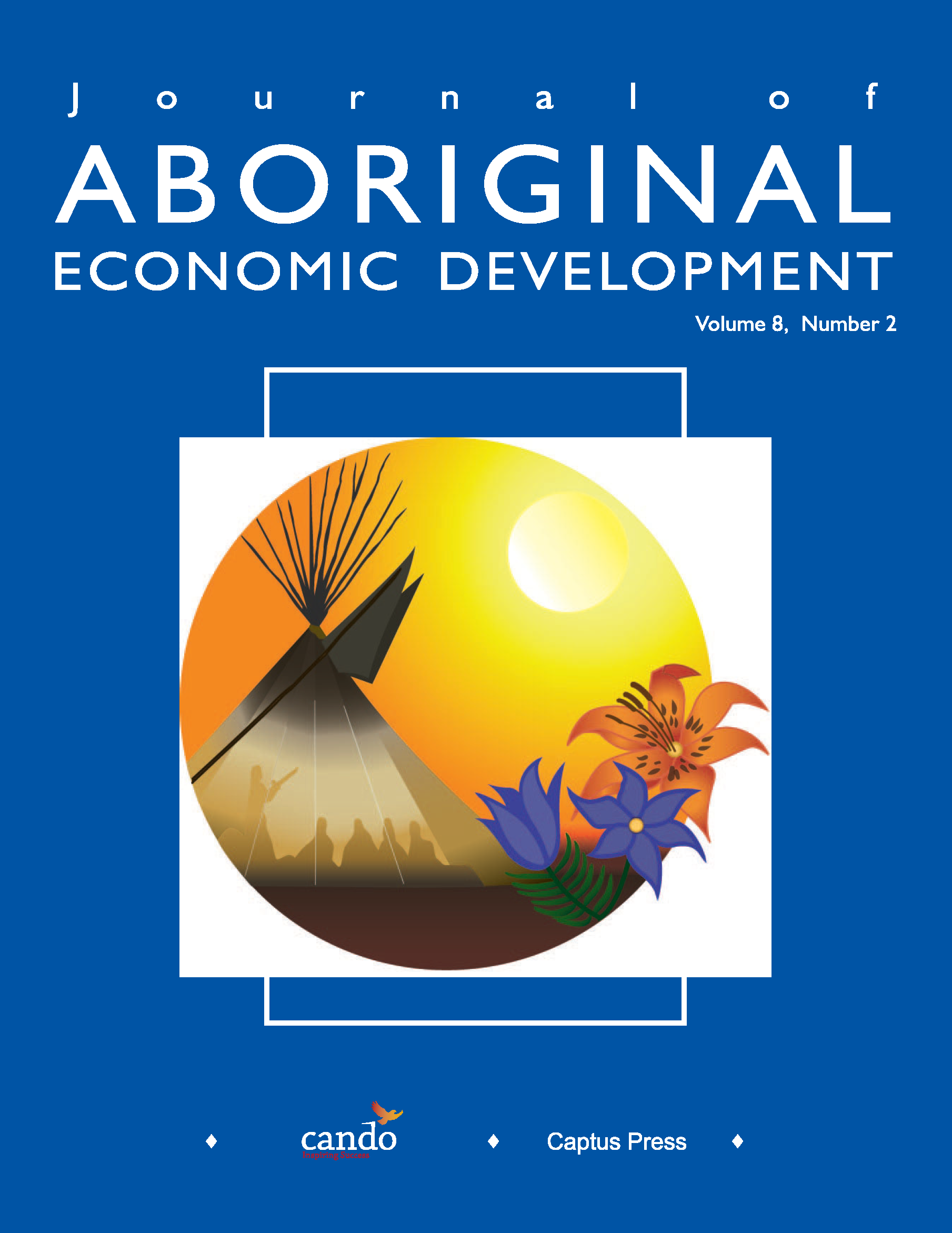Land Management on First Nations Reserves: Lawful Possession and Its Determinants
DOI:
https://doi.org/10.29173/jaed526Abstract
Much debate concerning property rights on reserves in Canada focuses on socio-economic impacts and the potential for individualized land tenure to support economic development, thereby reducing poverty. Study of existing forms of individual property on reserves is needed to inform these debates. In this article, we examine data on the lawful possession (Certificate of Possession) system that is currently used on reserves across Canada. We provide descriptive statistics regarding the variability of lawful possessions across First Nations and using regression analysis we assess which socio-economic, demographic, and locational variables influence the use of lawful possessions instead of communal land or other customary land holding systems. We show that use of the lawful possession system is surprisingly low and very uneven. As well, our regression results suggests that using the system requires a relatively educated community with low levels of poverty, with a favourable geographic location. Overall, the results are consistent with the view that lawful possessions are not primarily used to foster economic development.
Downloads
References
AANDC. 2012. Frequently Asked Questions — Reserve Land and Environment Management Program (RLEMP). Retrieved February 7, 2013, from <http://www.aadncaandc.gc.ca/eng/1332335905413/1332335993055>.
AANDC. 2013. First Nations. Retrieved February 12, 2013, from <http://www.aadncaandc.gc.ca/eng/1100100013791/1100100013795>.
Alcantara, C. 2008. “Privatize Reserve Lands? No. Improve Economic Development Conditions on Canadian Indian Reserves? Yes”. Canadian Journal of Native Studies 28(2): 421.
Alcantara, C. 2006. “Indian Women and the Division of Matrimonial Real Property on Canadian Indian” Reserves. Canadian Journal of Women and the Law 18(2): 513–33.
Alcantara, C. 2005. “Certificates of Possession and First Nations Housing A Case Study of the Six Nations Housing Program Certificates of Possession and First Nations Housing?: A Case Study of the Six Nations Housing Program”. Canadian Journal of Law and Society 20(2): 183–205.
Alcantara, C. 2003. “Individual Property Rights on Canadian Indian Reserves: The Historical Emergence and Jurisprudence of Certificates of Possession”. The Canadian Journal of Native Studies 23(2): 391–424.
Anderson, T.L., & D.P. Parker. 2009. “Economic Development Lessons from and for North American Indian Economies”. Australian Journal
of Agricultural and Resource Economics 53(1): 105–127.
Aragon, F., M. Brinkhurst & A. Kessler. forthcoming. Socio-Economic Impacts of Lawful Possession on Reserves in Canada, mimeo.
Ballantyne, B. 2010. Surveys, Parcels and Tenure on Canada Lands. Edmonton: Natural Resources Canada.
Ballantyne, B., & J. Dobbin. 2000. Options for Land Registration and Survey Systems on Aboriginal Lands in Canada. Ottawa: Legal Surveys Division, Geomatics Canada.
Bartlett, R.H. 1990. Indian Reserves and Aboriginal Lands in Canada: A Homeland — A Study in Law and History. Saskatoon, SK: University of
Saskatchewan Native Law Centre.
Baxter, J., & M. Trebilcock. 2009. “Formalizing Land Tenure in First Nations: Evaluating the Case for Reserve Tenure Reform”. Indigenous Law
Journal 7(2): 45–122.
Bruce, J.W. 1998. “Review of Tenure Terminology”. Tenure Brief (1): 18.
Chawathil First Nation. 2010. Chawathil First Nation So olh Temexw (Our Land) Community Land Use Plan. North Vancouver: David Nairne and
Associates.
Cowichan Tribes. 2011. Certificate of Possession. Retrieved from <http://cowichantribes.com/about/Facts/LandBase/Certificate of Possession?print Cowichan Tribes>
De Soto, H. 2000. The Mystery of Capital: Why Capitalism Triumphs in the West and Fails Everywhere Else. New York: Basic Books.
First Nations Land Management Act, S.C. 1999, c. 24.
Fiscal Realities Economists. 2010. “Property Rights, Governance and Property Values Realizing the Economic Potential of First Nation Lands”. First Nations Property Ownership Conference, October 20, 2010, Vancouver, BC.
Fiscal Realities Economists. 2007. The Economic and Fiscal Impacts of Market Reforms and Land Titling for First Nations. Kamloops, BC: Indian Taxation Advisory Board and DIAND.
Fiss, T. 2005a. “Let Natives Choose Series: Building An Ownership Society”. National Post (March 18), p. A.22.
Fiss, T. 2005b. “Land ownership needs new system”. Burnaby Now (May 25), p. 6.
Flanagan, T. 2000. First Nations? Second Thoughts. Kingston: McGill-Queens University Press.
Flanagan, T., C. Alcantara & A. Le Dressay. 2011. Beyond the Indian Act: Restoring Aboriginal Property Rights. Montreal: McGill-Queens University Press.
FNTC. 2010. The First Nations Property Ownership Initiative. A Discussion Paper: Who Should Own Reserve Lands? Retrieved from
www.fntc.ca/>.
Geomatics Services AANDC. 2012. Reserves lands data.
Imai, S. 2011. The 2012 Annotated Indian Act and Aboriginal Constitutional Provisions. Toronto, ON: Carswell.
INAC. 2005. Band Classification Manual. Retrieved from <http://www.collectionscanada.gc.ca/webarchives/20071206003642/><http://www.ainc-inac.gc.ca/pr/pub/fnnrg/2005/bandc_e.pdf>
INAC. 1982. Strengthening Indian Band Government in Canada and Alternative of Optional Indian Band Government Legislation. Ottawa: Government of Canada.
Kline, J. 2012. “Private Property Rights Are Key to the Future Prosperity of First Nations”. National Post (February 4).
Kydd, D.L. 1989. Indian Land Holdings on Reserve. Vancouver: Legal Services Society of British Columbia.
McHardy, M., & E. O’Sullivan. 2004. First Nations Community Well-Being in Canada: The Community Well-Being Index (CWB), 2001. Ottawa:
Strategic Research and Analysis Directorate Indian and Northern Affairs Canada.
Nemoto, A. 2002. “Dynamics of Aboriginal Land Use Institutions: The Rise and Fall of Community Control over Reserve Systems in the Lil’Wat
Nation, Canada”. Canadian Journal of Native Studies 22(2): 207–237.
Place, C. 1981. An Historical Review of the Reserve Allotment System. Ottawa, ON: Department of Justice.
Rakai, M.E.T. 2005. A Neutral Framework for Modelling and Analysing Aboriginal Land Tenure Systems. Engineering. PhD Dissertation, Geodesy and Geomatics Engineering, University of New Brunswick.
Statistics Canada. 2010. 2006 Census: Aboriginal Peoples in Canada in 2006: Inuit, Métis and First Nations, 2006 Census: First Nations People.
Retrieved February 12, 2013, from <http://www12.statcan.ca/census-recensement/2006/as-sa/97-558/p16-eng.cfm>.
Wassimi, S. 2009. Community Remoteness and Birth Outcomes among First Nations in Quebec. Montreal: Université de Montréal.
Yuen, J. 2009. “Overview of Aboriginal Land Regimes in British Columbia”. In M.J. McDonald, D. Jordan & The Continuing Legal Education
Society of British Columbia (Eds.), Aboriginal Law: Solicitors Issues 2009 Update. Vancouver: The Continuing Legal Education Society of British Columbia.
Downloads
Published
Issue
Section
License
Copyright (c) 2013 Cando

This work is licensed under a Creative Commons Attribution-NonCommercial-NoDerivatives 4.0 International License.




